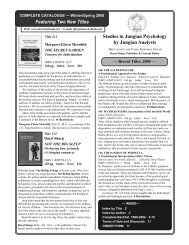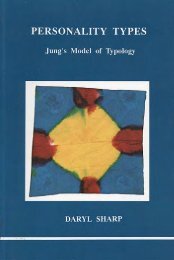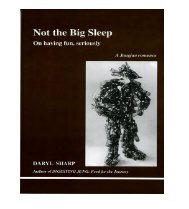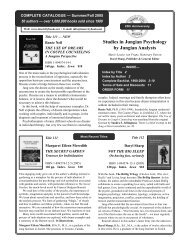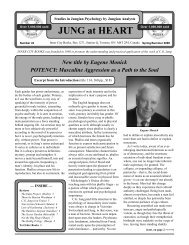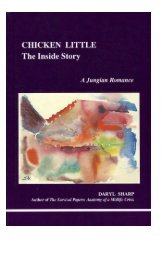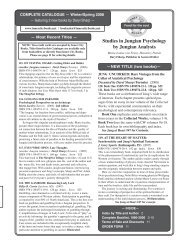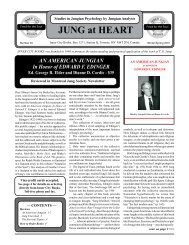Digesting Jung: Food for the Journey - Inner City Books
Digesting Jung: Food for the Journey - Inner City Books
Digesting Jung: Food for the Journey - Inner City Books
Create successful ePaper yourself
Turn your PDF publications into a flip-book with our unique Google optimized e-Paper software.
44 Man’s <strong>Inner</strong> Woman<br />
so to speak. That is to say, as one personification of <strong>the</strong> anima is<br />
consciously understood, it is supplanted by ano<strong>the</strong>r. Anima development<br />
in a man is thus a continuous process of death and rebirth.<br />
An understanding of this process is very important in surviving <strong>the</strong><br />
transition stage between one anima-image and <strong>the</strong> next. Just as no<br />
real woman relishes being discarded <strong>for</strong> ano<strong>the</strong>r, so no anima-figure<br />
willingly takes second place to her upstart rival. In this regard, as in<br />
so much else involved in a person’s psychological development, <strong>the</strong><br />
good is <strong>the</strong> enemy of <strong>the</strong> better. 25 To have made contact with your<br />
inner woman at all is a blessing; to be tied to one that holds you<br />
back can be fatal.<br />
While <strong>the</strong> old soul-mate clamors <strong>for</strong> <strong>the</strong> attention that now, in order<br />
<strong>for</strong> <strong>the</strong> man to move on, is demanded by and due to <strong>the</strong> new<br />
one, <strong>the</strong> man is often assailed by conflicting desires. The struggle is<br />
not just an inner, metaphorical one; it also involves his lived relationships<br />
with real women. The resultant suffering and inner turmoil,<br />
<strong>the</strong> tension and sleepless nights, are comparable to what occurs<br />
in any conflict situation.<br />
As <strong>the</strong> mediating function between <strong>the</strong> ego and <strong>the</strong> unconscious,<br />
<strong>the</strong> anima is complementary to <strong>the</strong> persona and in a compensatory<br />
relationship to it. That is to say, all those qualities absent from <strong>the</strong><br />
outer attitude will be found in <strong>the</strong> inner. <strong>Jung</strong> gives <strong>the</strong> example of<br />
a tyrant tormented by bad dreams and gloomy <strong>for</strong>ebodings:<br />
Outwardly ruthless, harsh, and unapproachable, he jumps inwardly<br />
at every shadow, is at <strong>the</strong> mercy of every mood, as though he were<br />
<strong>the</strong> feeblest and most impressionable of men. Thus his anima contains<br />
all those fallible human qualities his persona lacks. 26<br />
Similarly, when a man identifies with his persona, he is in effect<br />
possessed by <strong>the</strong> anima, with all <strong>the</strong> attendant symptoms.<br />
Identity . . . with <strong>the</strong> persona automatically leads to an unconscious<br />
25 <strong>Jung</strong>: “If better is to come, good must step aside.” (“The Development of Personality,”<br />
The Development of Personality, CW 17, par. 320.<br />
26 “Definitions,” Psychological Types, CW 6, par. 804.



